Howard the Duck (film)
3 /10 1 Votes
14% Rotten Tomatoes Genre Action, Adventure, Comedy Country United States | 4.5/10 IMDb Budget 36 million USD Duration Language English | |||||||||||||||||||||||||||||||||
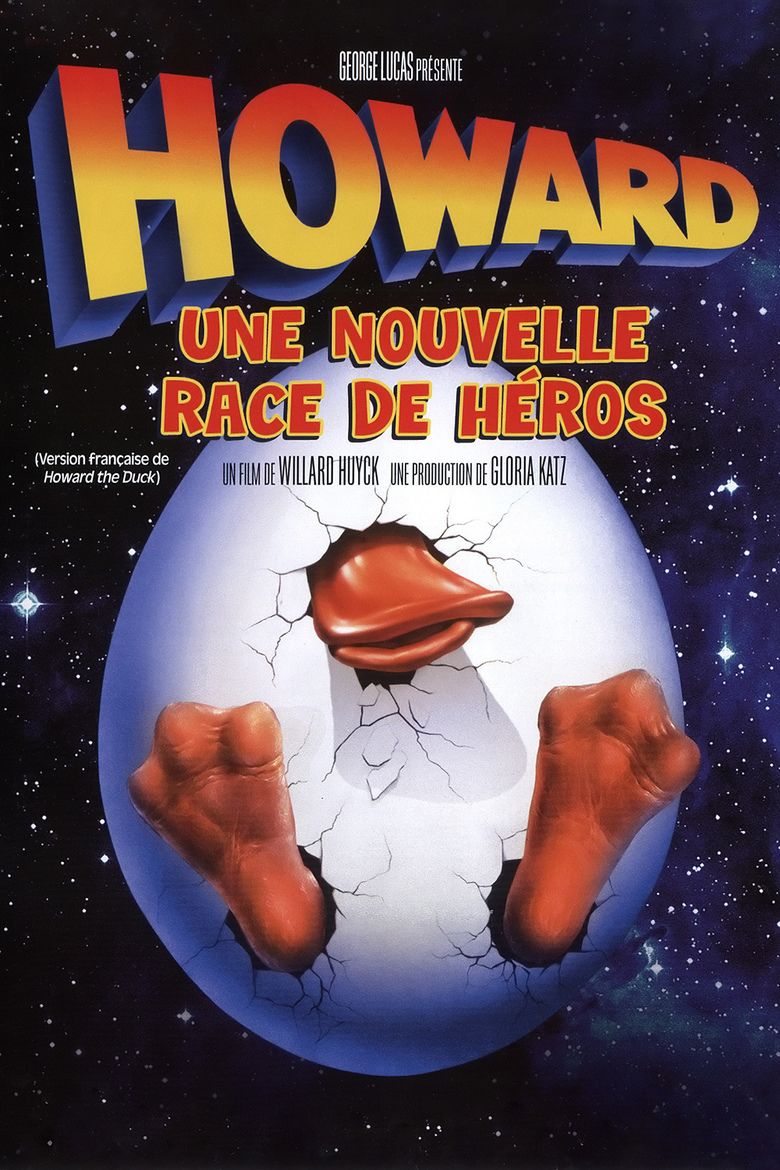 | ||||||||||||||||||||||||||||||||||
Release date August 1, 1986 (1986-08-01) Cast (Beverly Switzler), (Dr. Walter Jenning), (Phil Blumburtt), Ed Gale (Howard T. Duck), (Cal, Cherry Bomb), Holly Robinson Peete (K.C., Cherry Bomb)Similar movies Edge of Tomorrow , Independence Day , Mars Needs Moms , Monsters: Dark Continent , Monsters , Invasion of Astro-Monster Tagline You will believe that a duck can talk. | ||||||||||||||||||||||||||||||||||
Howard the duck 6 10 movie clip intense animal magnetism 1986 hd
Howard the Duck (titled Howard: A New Breed of Hero in the UK) is a 1986 American science-fiction comedy film directed by Willard Huyck and starring Chip Zien, Lea Thompson, Jeffrey Jones, and Tim Robbins. Produced by Gloria Katz and written by Huyck and Katz, with George Lucas as executive producer, the screenplay was originally intended to be an animated film based on the Marvel comic book of the same name, but the film adaptation became live-action because of a contractual obligation. Although several TV adaptations of Marvel characters had aired during the preceding 21 years, this was the first theatrical released film after the serial Captain America.
Contents
- Howard the duck 6 10 movie clip intense animal magnetism 1986 hd
- Plot
- Cast
- Production
- Development
- Adaptation
- Special effects
- Casting
- Soundtrack
- Critical response
- Box office
- Home media
- Novelization
- Legacy
- Howard the duck 1 10 movie clip no more mr nice duck 1986 hd
- References
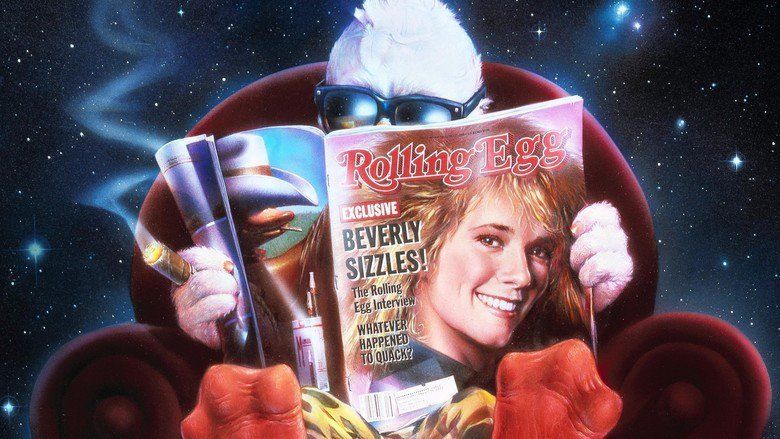
Lucas proposed adapting the surrealist comic book following the production of American Graffiti (1973). Following multiple production difficulties and mixed response to test screenings, Howard the Duck was released in theaters on August 1, 1986. Upon its release, the film was a critical and commercial failure. It was nominated for seven Razzie awards, and made about $15 million domestically compared to its $30 million budget. Contemporary critics saw the decision to shoot the film in live action instead of as an animated film and the appearance of Howard as primary obstacles to its success, while more recent commentators tend to focus on the film's writing. Despite the criticism, it has gained a cult following among fans of the comic-book series.
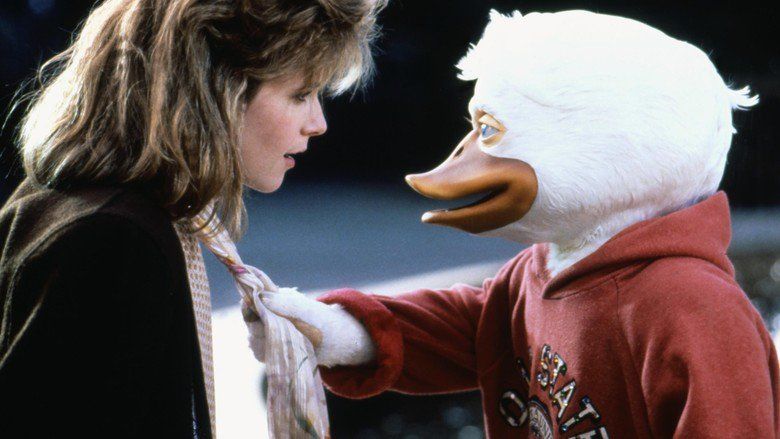
Plot

27-year-old Howard the Duck lives on Duckworld, a planet similar to Earth, but inhabited by anthropomorphic ducks and orbited by twin moons. As he is reading the latest issue of Playduck magazine, his armchair begins to quake violently and propels him out of his apartment building and into outer space; Howard eventually lands on Earth, in Cleveland, Ohio. Upon arriving, Howard encounters a woman being attacked by thugs. He defeats them using a unique style of martial arts. After the thugs flee, the woman introduces herself as Beverly Switzler, and decides to take Howard to her apartment and let him spend the night. The following day, Beverly takes Howard to Phil Blumbertt, a scientist who Beverly hopes can help Howard return to his world. After Phil is revealed to be only a janitor, Howard resigns himself to life on Earth and rejects Beverly's aid. He soon applies for a job as a janitor at a local romance spa. Howard soon quits and rejoins Beverly, who plays in a band called Cherry Bomb. At the club where Cherry Bomb is performing, Howard comes across their manager, and confronts him when he insults the band. A fight breaks out, in which Howard is victorious.
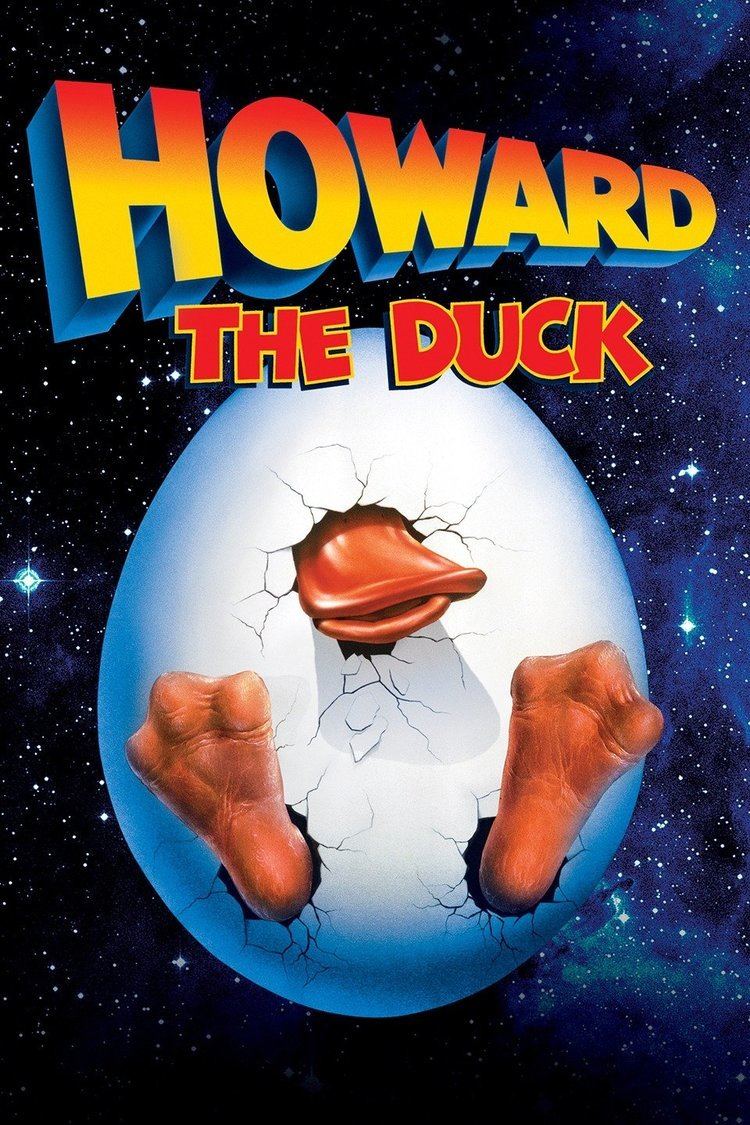
Howard rejoins Beverly backstage after the band's performance and accompanies her back to her apartment, where Beverly persuades him to be the band's new manager. The two begin to flirt, but they are interrupted by Blumburtt and two of his colleagues, who reveal that a laser spectroscope they were inventing was aimed at Howard's planet and transported him to Earth when it was activated. They theorize that Howard can be sent back to his world through a reversal of this same process. Upon their arrival at the laboratory, the laser spectroscope malfunctions when it is activated, raising the possibility of something else being transported to Earth. At this point, Dr. Walter Jenning is possessed by a life form from a distant region of space. When they visit a diner, the creature introduces itself as a "Dark Overlord of the Universe" and demonstrates its developing mental powers by destroying table utensils and condiments. A fight ensues when a group of truckers in the diner begins to insult Howard. Howard is captured and is almost killed by the diner chef, but the Dark Overlord destroys the diner and escapes with Beverly.
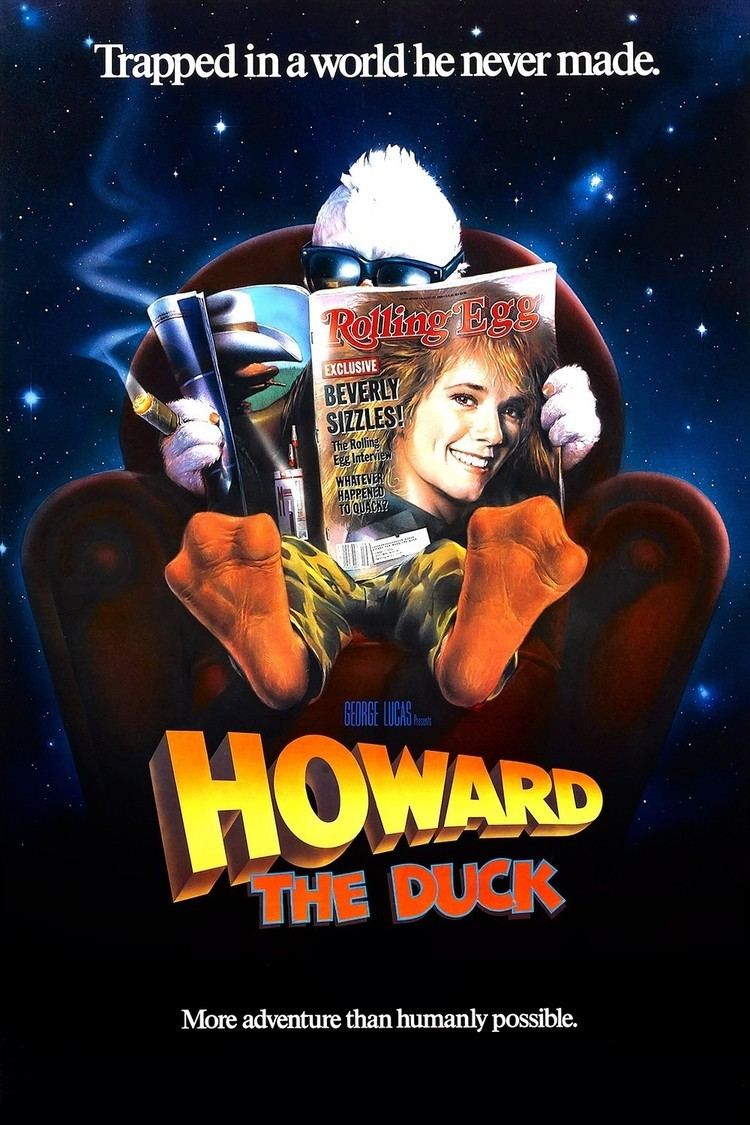
Howard locates Phil, who is arrested for his presence at the laboratory with no security clearance. After they escape, they discover an ultralight aircraft, which they use to search for the Dark Overlord and Beverly. At the laboratory, the Dark Overlord ties Beverly down to a metal bed and plans to transfer another one of his kind into her body with the dimension machine. Howard and Phil arrive and apparently destroy the Dark Overlord with an experimental "neutron disintegrator". However, the creature has only been forced out of Jenning's body. The Dark Overlord reveals his true form at this point. Howard fires the neutron disintegrator at the hideous beast, obliterating him. He then destroys the laser spectroscope, preventing more Dark Overlords from arriving on Earth, but also ruining Howard's only chance of returning to his planet. Howard then becomes Beverly's manager, hires Phil as an employee on her tour, and plays guitar with Beverly on stage.
Cast
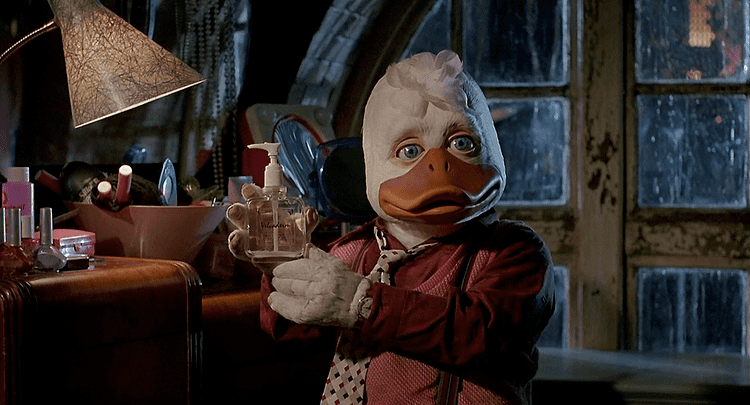
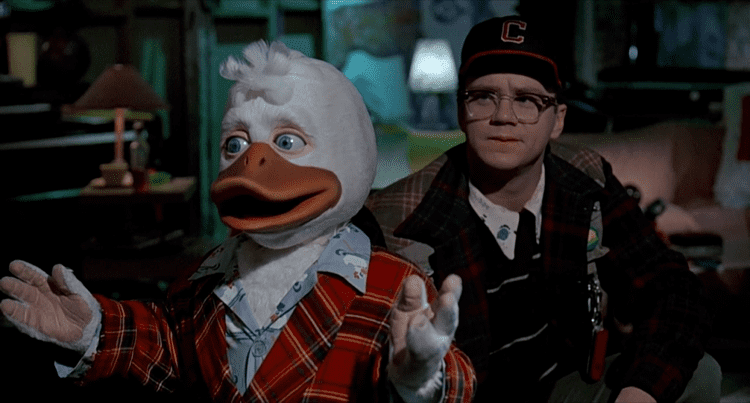
Production
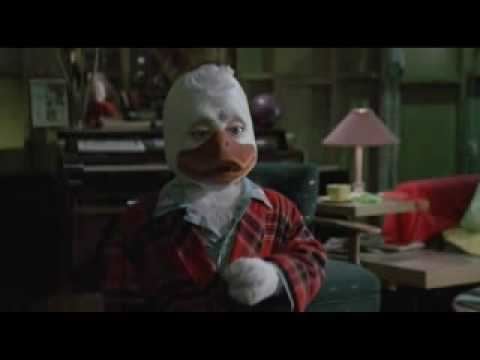
George Lucas attended film school with Willard Huyck and Gloria Katz, who later co-wrote American Graffiti with Lucas. After the film's production concluded, Lucas told Huyck and Katz about the comic book Howard the Duck, primarily written by Steve Gerber, describing the series as being "very funny" and praising its elements of film noir and absurdism. In 1984, Lucas relinquished his presidency of Lucasfilm to focus on producing films. According to the documentary A Look Back at Howard the Duck, Huyck, Katz and Lucas began to seriously consider adapting Howard the Duck as a film, and met with Gerber to discuss the project. Steve Gerber's account differs slightly; he recalls that at the time he was approached to discuss the film, Lucas was not yet involved with the project.
The film was optioned by Universal Studios after a partnership with Marvel Entertainment. According to Marvin Antonowsky, "Sidney [Sheinberg] lobbied very hard for Howard the Duck", because the studio had passed on previous projects in which Lucas was involved, which had been very successful. Sheinberg denied any involvement in Howard the Duck, claiming that he never read the screenplay. Huyck and Katz strongly felt that the film should be animated. Because Universal needed a film for a summer release, Lucas suggested that the film could be produced in live action, with special effects created by ILM.
Production designer Peter Jamison and director of photography Richard Kline were hired to give the film a look similar to that of a color comic book. Throughout the shoot, Huyck shot multiple segments establishing Duckworld, designed by Jamison. In the opening shot, the skyline displayed could easily be New York City but for the two moons visible in the sky (at similar angles from one another as the two suns of Tatooine in the original Star Wars film). Howard's apartment is filled with detailed props, including books and magazines featuring duck-oriented puns. Because Lucas often worked with dwarf actors, he was able to hire a number of extras to work on these sequences.
The ultralight sequence was difficult to shoot, requiring intense coordination and actors Tim Robbins and Ed Gale to actually fly the plane. The location scout was stumped for a location for the sequence; after she described what she was looking for, a telephone repairman working in her office in San Francisco suggested Petaluma for the scene. Because of the limited shooting time, a third unit was hired to speed up the filming process. The climax was shot in a naval installation in San Francisco, where conditions were cold throughout the shoot. The film cost an estimated $36 million to produce.
Though Gerber's schedule generally prevented him from being present during shooting, he chose to miss the deadline on the first issue of The Spectre so he could watch the final day of shooting.
Development
Huyck and Katz began to develop ideas for the film. Early on in the production, it was decided that the personality of the character would be changed from that of the comics, in which Howard was rude and obnoxious, to make the character nicer. Gerber read over the script and offered his comments and suggestions. In addition, Hyuck and Katz met with Gerber to discuss a horror sequence with which they were having difficulty.
During the screenwriting process, a stronger emphasis was placed on special effects, rather than satire and story. Overall, the tone of the film is in diametric opposition to the comics. Whereas Katz declared, "It's a film about a duck from outer space... It's not supposed to be an existential experience... We're supposed to have fun with this concept, but for some reason reviewers weren't able to get over that problem." Gerber declared that the comic-book series was an existental joke, stating, "'This is no joke!' There it is. The cosmic giggle. The funniest gag in the universe. That life's most serious moments and most incredibly dumb moments are often distinguishable only by a momentary point of view. Anyone who doesn't believe this probably cannot enjoy reading Howard the Duck." However, after shooting was finished, Gerber stated that he felt the film was faithful to both the spirit of the comic book and the characters of Howard and Beverly.
An early proposed storyline involved the character being transported to Hawaii. Huyck states that this storyline was considered because "we thought it would be sort of fun to shoot there". According to Katz, they did not want to explain how Howard arrived on Earth initially, but later rewrote the screenplay so that the film would begin on Howard's home world. Huyck and Katz wanted to incorporate both lighter, humorous elements and darker, suspenseful elements. Katz states that some readers were confused by the sexual elements of the screenplay, as they were unsure as to whether the film was intended for adults or children. Huyck and Katz wrote the ending leaving the story open for a sequel, which was never produced.
Adaptation
The film was originally intended to be animated based on the character created by Steve Gerber and quoting scripts by Bill Mantlo. In particular, the "Duckworld" story of Howard the Duck magazine #6 was to serve as a basis for the script. A contractual obligation required Lucas to provide a distributor with a live-action film, so he decided to make the film using live actors and to use special effects for Howard.
The script significantly altered the personality of the title character, played the story straight instead of as a satire, removed the surrealist elements, and added supernatural elements that could highlight special effects work done by Lucas' ILM.
The film itself was adapted into comic book format by writer Danny Fingeroth and artist Kyle Baker for Marvel Comics. The adaptation appeared in both Marvel Super Special #41 and in a three-issue limited series.
Special effects
Lucasfilm built animatronic suits, costumes, and puppets for the film. Because of the limited preparation time, varied "ducks" created for the film would explode or lose feathers, and multiple ducks were built with the wrong proportions. On the first day of shooting, the crew realized the poor quality of the effects when they found that the inside of the puppet's neck was visible when its mouth opened. Huyck repeatedly reshot scenes involving Howard as the animatronics were improved. Because multiple puppeteers were in charge of controlling different parts of the animatronic body, Huyck was unable to coordinate the shoot properly. In the opening sequence, Howard's chair is propelled out of his apartment by wires, which were later digitally erased by computer, an effect that was uncommon in 1986. The effect of the feathers on Howard's head becoming erect during the love sequence took months to prepare.
The voice of Howard, Chip Zien, was not cast until after shooting completed. Because Ed Gale's voice was difficult to hear when he wore his suit, Huyck ordered Gale to perform his scenes without speaking any of the required dialogue, which was later synchronized during the editing process. Lead puppeteer Tim Rose was given a microphone attached to a small speaker, which would allow Rose to speak the dialogue to help the actors respond to Howard's dialogue. While wearing his suit, Gale could only see through Howard's mouth, and had to sense his location without proper eyesight. Gale often had to walk backwards before beginning rehearsals. In between takes, a hair dryer was stuffed in Howard's bill to keep Gale cool. Gale taped two of his fingers together to wear the three-fingered hands created for the Howard costume. A total of six actors gave physical performances as Howard.
Gerber was impressed by the appearance of Howard, and commented, "It was very bizarre to meet it and ... realize not just that I created it - that would have been bizarre enough... you know, it was sort of like meeting a child I didn't know I had ..."
Makeup artists Tom Burman and Bari Dreiband-Burman and actor Jeffrey Jones discussed the appearance of the Dark Overlord character with Huyck and Katz, and developed the character's progressing looks. When Katz's daughter visited the set during the shoot, she was terrified by Jones' appearance in makeup. The diner sequence combines practical effects, including squibs and air cannons, with visual effects created by ILM. Sound designer Ben Burtt created the voice of the Dark Overlord by altering Jeffrey Jones' voice as his character transformed. Stop motion effects during the climax were designed by Phil Tippett, who began with a clay model before upgrading to more sophisticated pieces.
Casting
After auditioning a number of actresses, singers, and models for the role of Beverly, Lea Thompson was cast in the role, because of her appearance in Back to the Future. Thompson purchased clothing from thrift stores because she wanted to appear at the audition as "a cross between Madonna and Cyndi Lauper." During the shoot, Thompson complained that the filmmakers chose to shoot Howard's closeup before hers. Thompson also states that she regrets not wearing a wig, as her hairstyle took two hours a day to prepare. Jeffrey Jones was cast because of his performance in Amadeus. Although Tim Robbins had not appeared in many films, Huyck and Katz were confident that he was right for the part.
To play the physical role of Howard, Huyck and Katz held casting calls with dwarf actors, eventually casting a child actor and hiring Ed Gale, who had been rejected because he was too tall for the role, to perform stunts and portray the role during evening shoots. The child actor found the shooting conditions to be too difficult to handle, and the film's editors were unable to match day and evening sequences because of the difference in the two portrayals. Because Gale also served as an understudy, he took over the role.
After the film was completed, Huyck and Katz auditioned John Cusack, Jason Alexander, and Martin Short for the voice of Howard, eventually casting Chip Zien, because they felt his nasally voice worked well for the part. Because Howard's voice was not cast until the film had begun editing, synchronization was extremely difficult.
Soundtrack
The film's score was written by John Barry, although some of it was replaced by material composed by Sylvester Levay (most notably the music for the scene where Howard and Phil fly the ultralight - Barry's original cue is heard on the soundtrack album). Thomas Dolby wrote the film's songs, and chose the members of Cherry Bomb. Actress Lea Thompson performed her own singing for the role, although she states that the filmmakers were unsure as to whether they would keep her vocals in the final film. Thompson was required to learn choreography with the band and record the songs so they could be synchronized during filming. The final sequence, in which Cherry Bomb performs the film's title song, was shot in front of a live audience in an auditorium in San Francisco. The song was co-written by Dolby and George Clinton. Gale was choreographed to dance and play guitar as Howard. Dolby built a special guitar for Gale to use for rehearsal and filming.
Critical response
Howard the Duck was widely panned by critics. The review aggregator website Rotten Tomatoes gives the film a score of 13%, based on 45 reviews, which makes it the lowest-rated Lucasfilm production. The site's consensus states: "While it has its moments, Howard the Duck suffers from an uneven tone and mediocre performances." Orange Coast writer Marc Weinberg and Leonard Maltin criticized the decision to shoot the film in live action. Maltin described the film as a "hopeless mess ... a gargantuan production which produces a gargantuan headache". The appearance of Howard was criticized as being unconvincing due to his poorly functioning mouth, drunkenness, pervertedness, and expressionless face. Reviewers also criticized the acting and humor and found the film boring. In The Psychotronic Video Guide, Michael Weldon described the reactions to Howard as being inconsistent, and, "It was obviously made in LA and suffers from long, boring chase scenes", but praised the stop-motion special effects in the film's final sequences. The film received seven Golden Raspberry Award nominations in 1987 including Worst Supporting Actor (Tim Robbins), Worst Director and Worst Original Song ("Howard the Duck"). It won four trophies for Worst Screenplay, Worst New Star ("the six guys and gals in the duck suit"), Worst Visual Effects, and Worst Picture, tied with Under the Cherry Moon. The movie also won a Stinkers Bad Movie Awards for Worst Picture.
Box office
The film was considered a box-office bomb, grossing $16,295,774 in the United States and $21,667,000 worldwide for a total of $37,962,774, just under $1 million above the production budget. When the film was screened for Universal, Katz said that the studio's executives left without commenting on the film. Screenings for test audiences were met with mixed response. Rumors suggested that Universal production heads Frank Price and Sidney Sheinberg engaged in a fistfight after arguing over who was to blame for green-lighting the film. Both executives denied the rumors. News reports speculated that one or both would be fired by MCA chairman Lew Wasserman. Price soon left the studio, and was succeeded by Tom Pollack. The September 17, 1986, issue of Variety attributed Price's departure to the failure of the film (Duck cooks Price's goose, read the now-famous headline), though he had not approved the film's production. Following the film's failure, Huyck and Katz left for Hawaii and refused to read reviews of the film.
In 2014, the Los Angeles Times listed the film as one of the costliest box-office flops of all time.
Home media
Howard the Duck was released on VHS in January 1987. It was released on a Special Edition DVD by Universal Studios Home Entertainment on March 10, 2009. The film was released on Blu-ray for the first time on March 8, 2016.
Novelization
A novelization of Howard the Duck was written by former National Lampoon editor Ellis Weiner. Despite the negative reaction to the film, the novelization has achieved a cult following in recent years. In a 2016 review, Den of Geek wrote:
"In light of the 30th anniversary of Howard's cinematic debut, we recently reread this 232-page masterpiece and can say without any sense of detached irony or manufactured whimsy that Weiner's work would be right at home amongst the work of Douglas Adams, Kurt Vonnegut, and Daniel Manus Pinkwater in the sci-fi/humor section of your personal library."
Legacy
The negative reaction to the film had a difficult effect on the cast, who found themselves unable to work on other projects because of the film. The bad press right at the opening weekend had Lea Thompson accepting a role in Some Kind of Wonderful, which she had refused previously, because, as she said, "I had to get on another movie, I wouldn’t have done the movie if Howard wasn’t such a bomb.” However, Thompson and Robbins have had successful acting careers since then, with Robbins winning an Academy Award for his performance in 2003's Mystic River. Jones had a moderate career following the film, being featured prominently in films such as Beetlejuice, Mom and Dad Save the World, Ed Wood, and The Devil's Advocate. Zien found fame on Broadway, starring in the original cast of Stephen Sondheim's Into the Woods.
According to Ed Gale, he was hired to work on Spaceballs because Mel Brooks had said, "Anybody who's in Howard the Duck can be in my movie." Gale also said he receives more fan mail for his Howard the Duck portrayal than for his Chucky performances, the antagonist in the Child's Play horror film series. After the film's release, Huyck and Katz chose to work on more dramatic projects to separate themselves from Howard the Duck. Katz said Lucas continued to support the film after its failure, because he felt it would later be seen in a better light than it had been at the time of its release. Huyck said he later encountered fans and supporters of the film who felt that it had been unfairly treated by critics. Lea Thompson has stated that she had fun making the film and is happy to find fans "celebrating Howard the Duck in all its great silliness and blemishes."
In June 2012, the YouTube series Marvel Super Heroes: What The--?! featured an episode starring Howard the Duck complaining to Marvel that his movie was not given a special Blu-ray re-release to celebrate its 25th anniversary. He eventually gets Joe Quesada to try to appeal to, and bribe, George Lucas into supporting the re-release.
Writer Chip Zdarsky, who took on Howard's comics in the 2010s, revealed he was a fan of the movie growing up, and had the 2016 run of the title featuring metafictional references to the film. The plot had Lea Thompson hiring Howard and discovering the villain Mojo had hypnotized her into playing Beverly opposite an alien in a Howard costume.
In an episode of the ABC comedy The Goldbergs, which is set in the 1980s, Solomon "Pops" takes his grandson, Adam, to see the film to restore his "child-like wonder."
Nostalgia critic also review Howard the duck citing an inappropriate scene in the movie.
Howard the duck 1 10 movie clip no more mr nice duck 1986 hd
References
Howard the Duck (film) WikipediaHoward the Duck (film) IMDbHoward the Duck (film) Rotten TomatoesHoward the Duck (film) themoviedb.org
